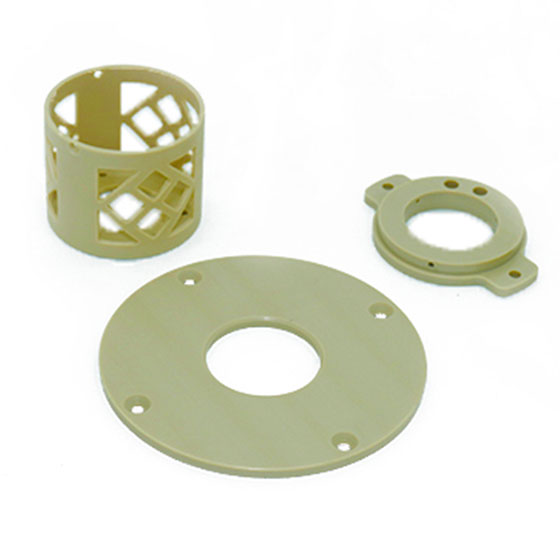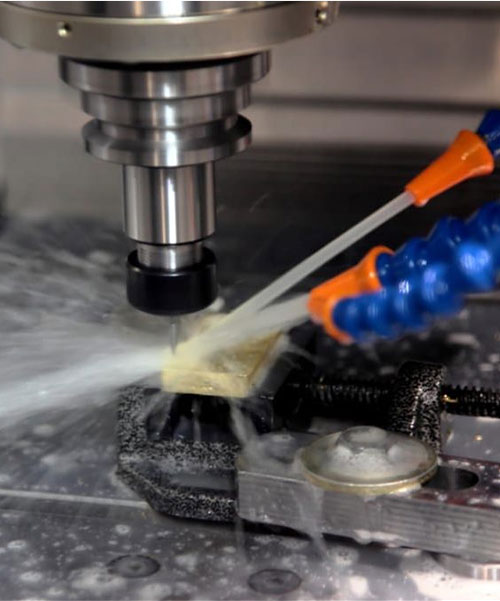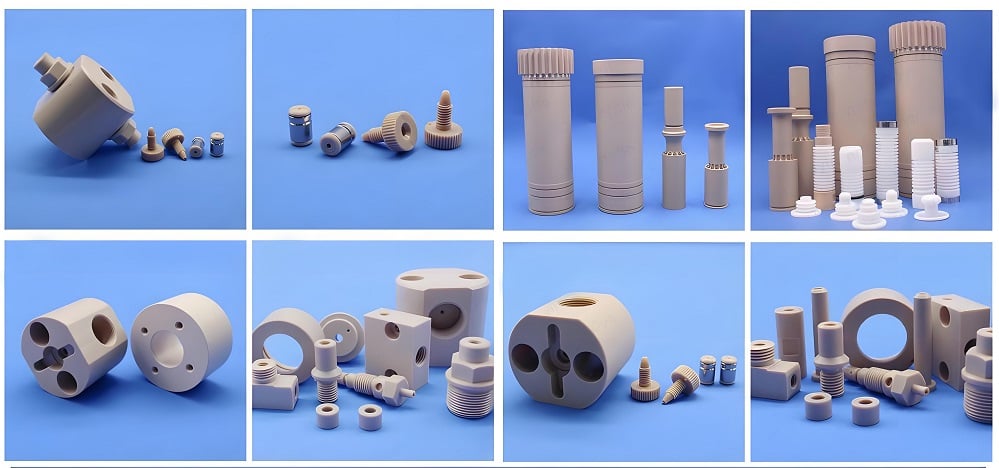PEEK CNC Machining Services | Custom Precision PEEK Parts Manufacturer – Junying
Solid PEEK material is readily machinable, CNC PEEK machining services are great solutions to produce high-quality PEEK parts with electrical and thermal insulation, as well as other benefits.
With decades of experience in plastic CNC machining, Junying works with a wide variety of plastic materials and PEEK grades. As a China-leading plastics and composite machining company, we can employ multi-axis CNC PEEK machining to ensure efficiency and accuracy, even the most complex geometries and tight tolerances are required. CNC machined PEEK parts are fabricated based on customer requirements or CAD drawings submitted, our engineers and designers will help you improve the models to gain the best outcomes and reduce costs. If you want to develop your project about PEEK (Polyether ether ketone) products or prototypes, we are glad to discuss all the details with you. Consistent communication will also be kept during the production cycle of PEEK machined parts. PEEK CNC machining services mainly reduce manufacturing errors and increase productivity, also deliver superb quality and precision.
CNC Machining PEEK – What is PEEK Plastic?
PEEK – full form Polyether ether ketone, is a semicrystalline thermoplastic polymer used for engineering applications, demonstrates excellent mechanical and chemical resistance properties that are retained to high temperatures. Due to its great strength, wear resistance, abrasion resistance, and chemical resistance, PEEK parts and products are ideal choices for lots of demanding fields, including aerospace, automotive, chemical, fluid, and high-temperature applications. PEEK plastic is available in bar and rod forms makes it suitable for CNC machining and cutting operations, including sawing, drilling, milling, and turning. You can get PEEK materials in glass-fiber, carbon fiber reinforced, bearing grade, medical grade, etc.
Why Choose PEEK for CNC Machining
- Chemical and water resistance
- Wear and abrasion resistance
- Low moisture absorption
- Biocompatibility (medical-grade)
- Lightweight substitute for most soft metals
- Highly resistant to thermal degradation
- Good robustness
- Compatible with ultra-high vacuum applications
- Good dimensional stability
- Excellent resistance to gamma and X-rays

PEEK Plastic Material Properties & Advantages |
|||
|---|---|---|---|
| Category | Property | Value | Standard / Notes |
| Physical Properties | Density (amorphous) | ≈1.30 g/cm³ | ISO 1183 |
| Density (crystalline) | 1.320 g/cm³ | — | |
| Water absorption (23°C) | ≤0.40% | ISO 62-1; excellent hydrolysis resistance | |
| Mechanical Properties | Tensile strength | ≈90 MPa | ISO 527 |
| Flexural modulus | 4.2 GPa | ISO 178; very high stiffness | |
| Wear resistance | 3–5× that of metals; low long-term wear | — | |
| Thermal Properties | Melting point | 343°C | ISO 11357 |
| Glass transition (Tg) | 143–162°C | ISO 11357 | |
| Long-term service temp. | ≤260°C | — | |
| Short-term peak temp. | ≤300°C | — | |
| Electrical Properties | Dielectric strength | ≈18 kV/mm | IEC 60243-1 |
| Dielectric constant (50 Hz) | ≈3.2 | IEC 60250 | |
| Chemical Properties | Chemical resistance | Resistant to many acids and bases | — |
| Biocompatibility | Medical use | Suitable for medical devices (e.g., implants, dental) | — |
| Other | Specific strength | Alloy-steel density is ~58% higher; carbon-fiber-reinforced PEEK can reach ≈200 MPa tensile strength | — |
Applications of CNC Machined PEEK Parts
PEEK (Polyether ether ketone) is a special engineering plastic with excellent performance. Compared with other engineering plastics, PEEK has more significant advantages and is widely used in aerospace, automobile manufacturing, electronics and electrical, medical, food processing, and other fields. PEEK material exhibits excellent properties such as high-temperature resistance, self-lubrication, easy processing, and high mechanical strength. It can be manufactured and processed into various mechanical parts, such as automobile gears, oil screens, and shift start discs; pipelines, valves, and pumps for conveying ultrapure water; aircraft engine parts, automatic washing machine runner, medical device parts, etc. It can still maintain good electrical insulation performance under harsh working conditions such as high temperature, high voltage, and high humidity. The field of electronic information has gradually become the second-largest application field of PEEK resin. PEEK not only has the advantages of lightweight, non-toxic, and corrosion resistance, but also is the closest material to human bone at present, and can be organically combined with the body. Therefore, using PEEK resin instead of metal to manufacture human bone is another important application in the medical field. PEEK has excellent physical and mechanical properties and can replace traditional materials such as metals and ceramics in many special fields

Why Choose Junying PEEK CNC Machining?
As a high-precision CNC machining service supplier with many years of industry experience, JUNYING is confident in providing precision PEEK Plastic CNC Machining design and processing services to customers in various industries around the world. Trust us, and the quality you need will exceed your expectations!
- Advanced machining technologies and equipment ensure accuracy and repeatability
- Tight tolerances, high precision, and custom specifications as request
- Right handling to minimize internal stress and avoid cracks in products
- On-site inspection and testing ensure the quality of materials and products
- Reduced setups and the number of difficulties to lower the cost and processing time
- A wide variety of surface finishes and material grades for selection

PEEK can be categorized into the following types based on its properties and applications:
- 1. Basic PEEK: This is the most common PEEK product, offering standard heat resistance, chemical resistance, and mechanical strength. It is widely used in a variety of applications requiring high-performance plastics.
- 2. Reinforced PEEK: Basic PEEK can be enhanced by adding materials such as fibers to improve its mechanical strength. Examples include glass fiber-reinforced PEEK and carbon fiber-reinforced PEEK. These reinforced PEEK grades offer increased stiffness and wear resistance while maintaining their original properties.
- 3. Sliding PEEK: This type of PEEK product places special emphasis on sliding properties and wear resistance. By adding a certain proportion of materials such as carbon fiber, graphite, or polytetrafluoroethylene (PTFE), sliding PEEK exhibits excellent low friction and wear resistance.
- 4. Conductive PEEK: The addition of conductive materials such as carbon fiber to basic PEEK enhances the material's electrical conductivity. This conductive grade of PEEK is often used in applications such as small electronic components that are sensitive to static electricity and dust.
- 5. Modified PEEK: PEEK can be modified through chemical or physical methods such as filling, blending, cross-linking, and grafting to create PEEK plastic alloys or PEEK composites with even better performance. These modified PEEK products are often custom-developed for specific application requirements.
We can provide the CNC-processed PEEK material that best suits your project. If you're undecided about which PEEK material to choose, please share your project's specific requirements. Our professional engineers will help you select the optimal choice – balancing cost and quality!
The following are some common PEEK surface treatment methods:
Polishing and grinding: After initial molding, PEEK may have a rough surface. Precision polishing or grinding with a grinding wheel can improve surface finish, reduce friction, and improve adhesion to other materials.
Electrodischarge machining: This non-contact machining method is suitable for creating high-precision holes or grooves. EDM does not cause thermal damage to PEEK and maintains its original mechanical properties.
Laser treatment: Laser beams can precisely cut or drill PEEK while maintaining extremely high surface quality. Laser treatment can also achieve surface modification, such as etching specific textures or increasing hydrophobicity.
Electroless coating: A metal or functional coating, such as a wear-resistant, corrosion-resistant, or conductive coating, is deposited on the PEEK surface through a chemical reaction, enhancing its overall performance.
Heat Treatment: PEEK can be heat-treated to alter its microstructure, affecting its hardness, toughness, and surface roughness. Appropriate heat treatment can enhance material properties and improve wear resistance.
Surface Modification: Plasma treatment or UV curing can create a functional layer on the PEEK surface, such as one with antimicrobial or antistatic properties or one that increases friction.
Assembly Pretreatment: Before assembly, cleaning, deburring, or applying lubricant to PEEK parts can reduce friction during assembly and protect the surface from scratches.
After performing precise PEEK CNC machining, JUNYING can provide high-quality surface treatment services according to customer needs.
Before polishing PEEK, it's important to understand its properties. PEEK has high hardness and toughness, so the polishing process requires appropriate abrasives and tools to avoid damaging the material. PEEK also has excellent heat resistance, allowing it to be polished at higher temperatures, which improves efficiency and polishing quality.
Steps for Polishing PEEK
1. Rough Grinding: Initially, use a coarser abrasive to perform a preliminary grinding of the PEEK surface to remove burrs and irregularities. Diamond or silicon carbide grinding wheels are recommended for this step, as they are hard and wear-resistant, effectively removing imperfections from the PEEK surface.
2. Fine Grinding: Following the rough grinding, further grinding is performed using a finer abrasive. This step aims to smooth the PEEK surface, laying the foundation for subsequent polishing. Fine-grit diamond sandpaper or a cloth wheel is recommended for fine grinding.
3. Polishing: After the first two steps, the PEEK surface is relatively smooth, but some minor scratches and blemishes may still remain. Therefore, it is necessary to polish the surface with a polishing agent. Abrasives such as aluminum oxide and cerium oxide can be used as polishing agents. The rotation and friction of the polishing machine will make the PEEK surface smoother and brighter.
Yes, PEEK is resistant to almost any chemicals except concentrated sulfuric acid. However, incompletely crystallized PEEK may experience stress cracking in solvents such as acetone.
Theoretically, there is no clear limit to the shelf life of PEEK plastic. It has excellent anti-aging properties and can be used for a long time if it is well packaged and stored under appropriate conditions.

